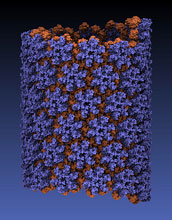ACADEMIA
NSF's Most Powerful SuperComputing Resource Has Opened Its Doors to Six Teams
From climate change to the HIV infection to the evolution of the universe, tool enables researchers to address some of the world's most challenging scientific questions
Six research teams have started to use the first phase of the Blue Waters sustained-petascale supercomputer to study some vexing problems in science and engineering from climate change to the HIV infection.
It's the first use of Blue Waters, which is on its way to becoming one of the most powerful supercomputers in the world.
"This is an exciting and important milestone in the Blue Waters project," said Irene Qualters, program director of the National Science Foundation's (NSF) Office of Cyberinfrastructure, which supports Blue Waters along with the University of Illinois' National Center for Supercomputing Applications (NCSA).
"It began as an idea," Qualters said, "and now thanks to sustained collaborative efforts by the entire project team, the vendor and researchers, this computational tool is beginning to advance fundamental understanding in a wide range of scientific topics."
Through a competitive process, NSF and NCSA awarded more than two dozen research teams Petascale Computing Resource Allocations--time to use Blue Waters on compelling research questions. From among these, a smaller group of six teams was selected to use the Early Science System before the full Blue Waters system is deployed later this year.
Those teams will pursue the following research:
- Modeling of high-temperature plasmas, including magnetic reconnection and flux transfer events to better understand the impact of the solar wind and solar flares on the Earth's atmosphere;
- Simulating the formation and evolution of the Milky Way's most distant ancestors, a population of small galaxies formed shortly after the Big Bang.
- Examining the protein that encases the HIV-1 genome. The process through which this protein disassembles, releasing its genetic material, is a critical step in HIV infection.
- Exploring explosive burning in Type Ia supernovae, which are used as "standard candles" for surveying astronomically vast distances, with unprecedented resolution afforded by a fine level of adaptive mesh refinement simulations.
- Simulating the end of both the 20th and 21st centuries to explore changes in the frequency and intensity of extreme events, such as tropical cyclones and mid-continental thunderstorms that are not adequately resolved in global climate models at lower resolution.
All of the more than two dozen teams are in line to use the full Blue Waters system when it is deployed.
The Blue Waters Early Science System is made up of 48 Cray XE6 cabinets and represents about 15 percent of the total Blue Waters computational system. It is currently the most powerful computing resource available through NSF.
Once fully deployed, Blue Waters is expected to make arithmetic calculations at a sustained rate in excess of 1,000-trillion operations per second (a "petaflop" per second). It will enable researchers across a variety of disciplines to tackle some of the most challenging research issues in science and engineering.
Read more about the first six projects to use the Early Science System on the NCSA Web site.

